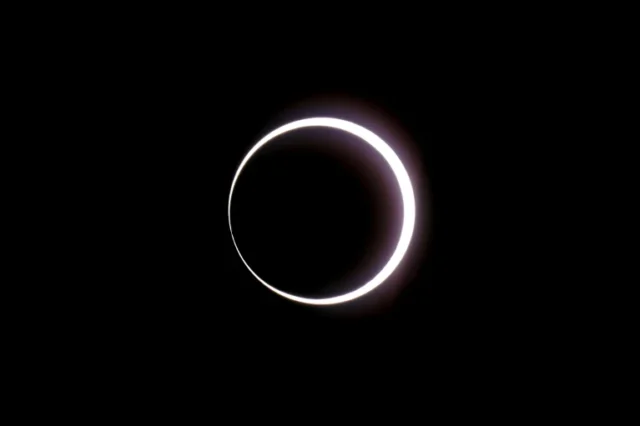
BY CLAIRE RUSH AND KATIE OYAN
ALBUQUERQUE, N.M.. (AP) — First came the darkening skies, then the crescent-shaped shadows on the ground, and finally an eruption of cheers by crowds that gathered Saturday along the narrow path of a rare “ring of fire” eclipse of the sun.
It was a spectacular show for millions of people across the Americas as the moon moved into place and the ring formed.
There were hoots, hollers and yelps for those with an unfettered view in Albuquerque, where the celestial event coincided with an international balloon fiesta that typically draws tens of thousands of spectators and hundreds of hot air balloon pilots from around the world.
They got a double treat, with balloons lifting off during a mass ascension shortly after dawn and then the eclipse just hours later. Some pilots used their propane burners to shoot flames upward in unison as the spectacle unfolded.
Saturday’s path: Oregon, Nevada, Utah, New Mexico and Texas in the U.S., with a sliver of California, Arizona and Colorado. Next: Mexico’s Yucatan Peninsula, Belize, Honduras, Nicaragua, Costa Rica, Panama, Colombia and Brazil. Much of the rest of the Western Hemisphere gets a partial eclipse.
In Mexico, hundreds of people filed into the planetarium in the Caribbean resort city of Cancun to watch the eclipse. Some people peered through box projectors, while others looked through telescopes and special glasses.
Excited children whistled, as some adults raised their arms towards the sky as if to welcome the eclipse.
“It is the third one that I have seen, but I come because of the energy it gives you. It is something that nature brings us and that we must watch,” said Pilar Cáceres, 77, a retired elementary school teacher who watched the eclipse through a piece of cardboard that reflected the shadow on the ground.
Cáceres wondered how the Maya civilization would observe the celestial event because they were fearful of the phenomenon despite being great astronomers. “We were told now that some Maya people thought that eclipses were a curse because they burned their eyes and made them blind,” she said.
The Maya — who called eclipses “broken sun” — may have used dark volcanic glass to protect their eyes, said archeologist Arturo Montero of Tepeyac University in Mexico City.
In the U.S., the event brought eclipse watchers to remote corners of the country to try to get the best view possible. At Bryce Canyon National Park in southern Utah, enthusiasts hit the trails before sunrise to stake out their preferred spots among the red rock hoodoos.
With the ring of fire in full form, cheers echoed through the canyons of the park.
“I just think it’s one of those things that unites us all,” said John Edwards, a cancer drug developer who traveled alone across the country to try to watch the eclipse from Bryce Canyon.
“Nothing that you can read could prepare you for how it feels,” said Kirby James, 63, a co-founder of a software company. “It’s the moment, especially when the ring of fire came on, you realized you were having a lifetime experience.”
For the small towns and cities along the path, there was a mix of excitement, worries about the weather and concerns they’d be overwhelmed by visitors flocking to see the annular solar eclipse.
In Eugene, Oregon, oohs and ahs combined with groans of disappointment as the eclipse was intermittently visible, the sun’s light poking through the cloud cover from behind the moon only at times.
“It was worth it to me because I like science,” she said.
Viewers on the East Coast saw much less of the event if anything. Much of the northeastern part of the region was socked in by clouds and rain.
In southern Colombia, the Tatacoa desert played host to astronomers helping a group of visually impaired people experience the eclipse through raised maps and temperature changes as the moon blots out the sun.
The dance between the sun and moon made for a perfect golden ring while the sky went dark over the desert.
Colombia Science Minister Yesenia Olaya said moments like this should inspire people to promote science among children, so they see it as “a life project.”
Juan Pablo Esguerra, 13, had been waiting months to make the trip to the desert with his father to witness the eclipse.
“I like astronomy because it’s a spectacular experience,” he said. “This is the best that I’ve seen in my life.”
Brazil’s Pedra da Boca state park, known for its rocky outcrops for climbing and rappelling, also was expecting crowds.
The entire eclipse — from the moment the moon starts to obscure the sun until it’s back to normal — is 2 1/2 to three hours at any given spot. The ring of fire portion lasts from three to five minutes, depending on location.
Next April, a total solar eclipse will crisscross the U.S. in the opposite direction. That one will begin in Mexico and go from Texas to New England before ending in eastern Canada.
The next ring of fire eclipse is in October next year at the southernmost tip of South America. Antarctica gets one in 2026. It will be 2039 before another ring of fire is visible in the U.S., and Alaska will be the only state in its direct path.
____
Rush reported from Eugene, Oregon. AP reporters Patrick Whittle in Portland, Maine; Susan Montoya Bryan in Albuquerque, New Mexico; Brady McCombs in Garfield County, Utah; Astrid Suarez in Bogota, Colombia; María Verza in Cancun, Mexico; Iván Valencia from Tatacoa Desert, Colombia; and Mauricio Savarese in Sao Paulo, Brazil, contributed to this report.












